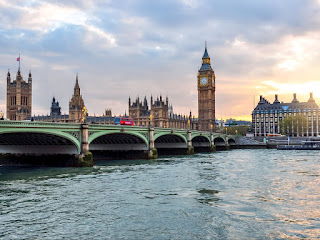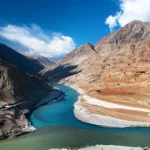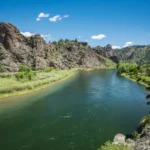
The River Thames is England’s longest river, running 215 miles from the Cotswolds to the North Sea. During the Roman occupation, the River Thames is thought to have been named ‘Tamesis,’ which means ‘dark water.’ A stone near Kemble marks the official source of the River Thames. Until it reaches urbanized areas like London, the land along the Thames is mostly made up of rolling hills and farmland. The Thames’s width varies from 60 feet at Lechlade to 18 miles at Whitstable and Foulness Point. The River Thames’s flow increases as it travels through England, picking up speed as tributaries add more water. Buscot, Reading, and Kingston are the main tributaries, adding approximately 2219 million gallons of water to the River Thames each day.
The River Thames was frozen for the first time in AD1150.
Today, the River Thames has 47 locks, 75 non-tidal bridges, and 29 tidal bridges.
The River Thames is a tidal river from Teddington onward.
The Thames estuary has a tidal range of 23 feet.
It is estimated that the River Thames transports 300,000 tonnes of sediment from its headwaters to the North Sea.
In the last 30 years, at least 119 different fish species have been discovered in the River Thames estuary.
Gloucestershire County, Wiltshire County, Oxfordshire County, Berkshire County, Buckinghamshire County, Surrey County, Essex County, and Kent County are all served by the Thames.
Cricklade, Lechlade, Oxford, Abingdon, Wallingford, Reading, Henley-on-Thames, Marlow, Maidenhead, Windsor, Staines-upon-Thames, Walton-on-Thames, Kingston upon Thames, Teddington, London, Dartford, Gravesend, and Southend are among the cities and towns along the Thames.
In 1843, the first underwater tunnel crossing the River Thames was built. This tunnel is now known as the East London Rail Line. The River Thames is now crossed by at least 17 tunnels.
The River Thames was once used for raw sewage disposal. Its use was suspended in 1858 because it became too stinky.
Despite its stinky, polluted past, the River Thames supplies approximately two-thirds of London’s drinking water.
Waterloo Bridge, at 1250 feet, is the longest bridge in central London.
There are over 190 islands along the River Thames from Kent to Oxfordshire. Only 45 of the River Thames’s islands are inhabited.
During the Blitz of World War II, pilots used the River Thames to help them navigate at night.
During the breeding and nursing seasons, seals can be found as far upstream as the Waterloo Bridge on the River Thames.
More than 60 shipping terminals are located in the tidal region of the River Thames.
The River Thames is popular among rowers, and there are over 200 rowing clubs on the river.
The River Thames has appeared in films and books. Alice in Wonderland, The Wind in the Willows, Three Men in a Boat, and several Charles Dickens novels all feature the famous river. It appeared in Indiana Jones and a number of other Hollywood feature films.









